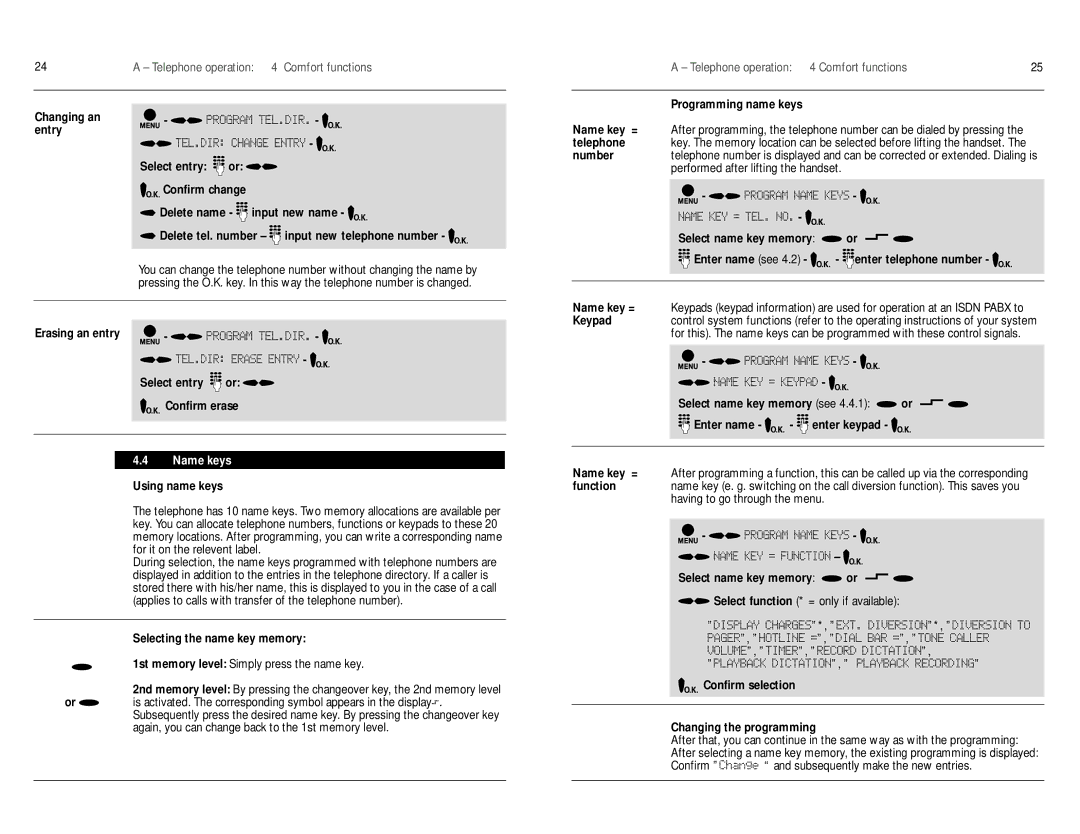
24 | A – Telephone operation: | 4 Comfort functions | |
Changing an | - |
| - |
entry |
|
| - |
|
|
| |
| Select entry: | or: |
|
| Confirm change |
| |
![]() Delete name -
Delete name - ![]()
![]()
![]() input new name -
input new name - ![]()
![]() Delete tel. number –
Delete tel. number – ![]()
![]()
![]() input new telephone number -
input new telephone number - ![]()
You can change the telephone number without changing the name by pressing the O.K. key. In this way the telephone number is changed.
Erasing an entry | - | - |
|
| - |
| Select entry | or: |
| Confirm erase | |
4.4Name keys
Using name keys
The telephone has 10 name keys. Two memory allocations are available per key. You can allocate telephone numbers, functions or keypads to these 20 memory locations. After programming, you can write a corresponding name for it on the relevent label.
During selection, the name keys programmed with telephone numbers are displayed in addition to the entries in the telephone directory. If a caller is stored there with his/her name, this is displayed to you in the case of a call (applies to calls with transfer of the telephone number).
Selecting the name key memory:
1st memory level: Simply press the name key.
2nd memory level: By pressing the changeover key, the 2nd memory level
or ![]() is activated. The corresponding symbol appears in the display . Subsequently press the desired name key. By pressing the changeover key again, you can change back to the 1st memory level.
is activated. The corresponding symbol appears in the display . Subsequently press the desired name key. By pressing the changeover key again, you can change back to the 1st memory level.
| A – Telephone operation: 4 Comfort functions | 25 |
|
|
|
| Programming name keys |
|
Name key = | After programming, the telephone number can be dialed by pressing the |
|
telephone | key. The memory location can be selected before lifting the handset. The |
|
number | telephone number is displayed and can be corrected or extended. Dialing is | |
| performed after lifting the handset. |
|
- | - |
- |
|
Select name key memory: | or |
Enter name (see 4.2) - | - enter telephone number - |
Name key = Keypads (keypad information) are used for operation at an ISDN PABX to
Keypadcontrol system functions (refer to the operating instructions of your system for this). The name keys can be programmed with these control signals.
- | - |
|
| - |
|
Select name key memory (see 4.4.1): | or | |
Enter name - | - enter keypad - |
|
Name key = After programming a function, this can be called up via the corresponding
functionname key (e. g. switching on the call diversion function). This saves you having to go through the menu.
- ![]() -
- ![]()
– ![]()
Select name key memory: ![]() or
or
![]() Select function (* = only if available):
Select function (* = only if available):
” | ”*, ” | ”*, ” |
”, ” | ”, ” | ”, ” |
”, ” | ”, ” | ”, |
” | ”, ” | ” |
Confirm selection |
|
|
|
|
|
Changing the programming
After that, you can continue in the same way as with the programming: After selecting a name key memory, the existing programming is displayed:
Confirm ” “ and subsequently make the new entries.
